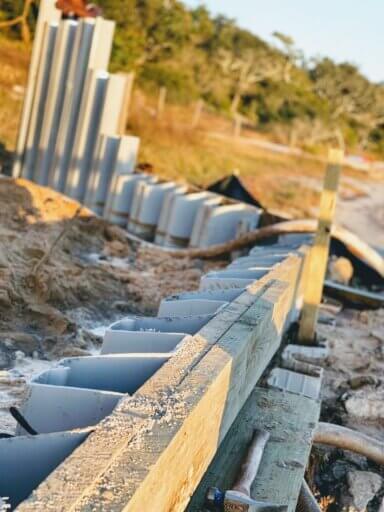How Do Seawalls Protect the Coast?
Shore erosion control is a significant problem in many parts of the world. Sea wall construction is becoming increasingly important as climate change reshapes weather conditions and impacts coastal communities. Exactly how do sea walls protect the coastline? Read on to discover the answer and learn more about the disadvantages of sea wall construction.

The Problem of Gulf Coast Erosion
Water erosion is a natural process that helps to form beaches and shape coastlines. Historically, natural features of the environment have helped to keep erosion in check. In the Gulf of Mexico, oyster reefs, coastal forests, marshes, and seagrass beds protected coastal areas. Unfortunately, rising sea levels due to climate change and the impact of human development have damaged and destroyed many of these natural buffers.
Climate changes directly influence coastal erosion in another vital way. As temperatures continue to rise, severe storms will become more frequent. Hurricanes and other severe storms produce strong surges that batter shorelines and wash away beaches, accelerating coastal erosion.
Weather changes due to climate change are already noticeable. A Pew Research study conducted in 2021 found that 67 percent of Americans believe that severe weather events are more common now than they were in the past. An increase in extreme weather is taking a noticeable financial toll on the United States. The National Centers for Environmental Information reports that between January and June 2021, the U.S. experienced 18 disasters that cost more than $1 billion to address. Hurricanes Nicholas and Ida and Tropical Storms Fred and Elsa were among these events, which impacted the Gulf Coast area.
Due to the destruction of natural barriers and the increase in severe weather, experts predict that water erosion in the Gulf Coast region will only worsen in years to come. If allowed to progress unabated, Gulf Coast erosion can:
- Destroy homes, businesses, and roads
- Disrupt ecosystems
- Damage beaches and lead to a decrease in tourism
- Harm commercial fishing operations
How Do Seawalls Protect the Coast?
With roughly 40% of the U.S. population living in coastal areas, controlling erosion is vital to protecting communities. Seawalls have been used since ancient times to protect coastlines. A seawall is a structure built parallel to the shore that defends the coastline from ocean waves. When a storm surge rushes in, the seawall deflects the wave’s energy back into the ocean. This not only helps to reduce erosion but also lowers the likelihood of flooding.
Advantages of a Seawall for Erosion Control
Some of the advantages of using a seawall for erosion control include:
- Effectiveness. Seawalls continue to be constructed because they are proven to work.
- Peace of mind. Seawalls are visible structures that provide reassurance to residents and tourists. The presence of a seawall is a visual reminder that steps are being taken to protect property from flooding and erosion threats.
- Inexpensive option. Compared to other shore erosion protection options, seawalls are economical because they usually use inexpensive, abundant materials like natural rocks.
- Longevity. Quality seawall construction methods can produce a structure capable of standing the test of time. The Marine and Coastal Sciences at Rutgers State University of New Jersey’s Shoreline Future Project estimates seawalls can last 50 to 100 years.
Disadvantages of Seawall for Coastal Erosion
Despite their many benefits, seawalls do have some disadvantages, including:
- Flanking erosion. Seawalls can’t run the length of the entire coastline. Instead, they are built to protect a particular area. The areas at the ends of the seawall become more vulnerable to erosion because the walls can deflect some of the wave energy sideways. Erosion at the ends of seawalls is called flanking erosion, and it can be somewhat reduced by the careful placement and design of seawalls. However, it’s not possible to eliminate flanking erosion.
- Limited access to the beach. Seawalls can make it more challenging to enter and exit beachfront areas.
- Disruptions in sediment flow. In addition to blocking waves, seawalls also interfere with the flow of organic and inorganic materials that form sediment. This can interfere with natural beach-making and may disrupt some ecosystems.
- Impacts on the view. A seawall may detract from the natural beauty of coastal areas.
- Ongoing maintenance. All seawalls require ongoing maintenance to remain in good condition. Fortunately, maintenance costs are usually far less than the expenses associated with storm damage and uncontrolled shore erosion.
Common Seawall Construction Methods
Three types of methods can be used to construct seawalls:
- Sheets. With this method, sheet piles are interlocked and then planted deep into the ground
- Above ground. With this method, a series of individual piles support a structure that is positioned above ground.
- Shore bottom. With this method, a large structure is built onto the seafloor. No piles are used to support the seawall.
Seawall Construction Specialists
If you’re faced with shore erosion, an expert in seawall construction in South Florida can assess the problem and recommend the best solution. HMP Marine specializes in sea walls for storm surge protection for residences and commercial businesses. Contact today to discuss shore erosion protection.
